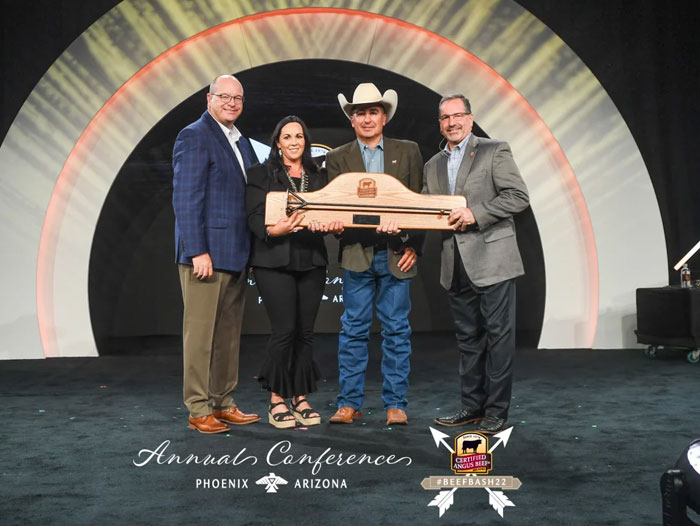New Mexico Ranch Earns Certified Angus Beef Sustainability Award
October 4, 2022 | 3 min to read

Producing beef in the desert Southwest takes a certain resolve, faith that the rain will come and grit to do the hard things and smile through the work when it doesn’t. This is the grit engrained in Manny and Corina Encinias and their seven children operating Buffalo Creek Ranch.
Sustainability runs deep for these stewards of a legacy that dates back to 1777, when the first generations of their family began herding sheep near Galisteo, N.M. Today they focus on cattle well-suited to the harsh desert range east of Albuquerque, fostering community strength and creating opportunities for others.
“My ranching philosophy is adapting to the ever-changing environment and marketing climates,” Encinias says.
Their holistic approach earned this ranching family the 2022 Certified Angus Beef (CAB) Sustainability Award.
Restoring the Land
Manny and Corina purchased Buffalo Creek Ranch in 2016 with a vision to restore the land and help it flourish.
“The first part of sustainability is consideration for the natural resources,” he says. “In the desert Southwest, those are fragile, yet resilient.”
Dormant grasses, the sound of a creek bed crunching beneath boots and a lone, green cottonwood point to the tenacity life requires in this part of the world. Named for the creek that typically runs through its heart, Buffalo Creek Ranch relies on water from a closed basin – and a monsoon season not seen in many years – to nourish its native grasses.
“Our gold in this country is water,” Encinias says. “And it’s what keeps me up at night. Water will always be of concern, for myself and future generations, because it is so precious. I don’t believe people recognize it as a fragile resource in everyday living here in the United States.”
Cattle are part of his plan to restore the land, taking care to only stock as many as the acreage can maintain.
In 2021, the family responded to persistent and extreme drought by downsizing to 90 of their best Angus-influenced cows. They stock at only 30% today – one cow for every 40 to 100 acres depending on the pasture.
Their genetic goals are multifaceted. Key considerations include Angus cattle that can adapt to the unforgiving environment yet achieve carcass merit and qualify for the Certified Angus Beef ® brand. Cows that stay must be easy fleshing and structurally sound, with maternal instincts and adapted to handle the 6,300-foot elevation. Those still thriving prove Angus cows can meet consumer demand for high quality in ways that work for both caretaker and landscape on which crops could never thrive.
The 98%
“The consumer drives a lot of what we do,” Encinias says. “We have embraced that as a responsibility. I think it’s important to have a seat at the table with the 98% not directly involved in agriculture, not only as beef consumers but as policy makers.”
Transparency across varied platforms helps define responsibility to the industry and welcomes visitors.
Foodservice salespeople and chefs stop in as part of CAB Ranch Days, learning what goes into a day’s work and a long-term plan. For example, Encinias explains the effect of water-saving night irrigation to limit evaporation and the stewardship of rotational grazing.
His efforts go beyond simply opening the ranch gate. Further education and helping with beef industry programs fit in with the family’s own progress and readiness to share principles on or off the ranch.
“I think Beef Quality Assurance (BQA) as a program has evolved to really take in a lot more of the important consumer-based issues like animal welfare,” Encinias shares.
As a former BQA trainer and state extension beef cattle specialist, I can attest to the program being about evaluating systems through the BQA principles, he says.
“We can all lend ourselves to becoming better – better handlers of animals and our environments,” he says.
Encinias teaches animal and meat sciences and ag business at Mesalands Community College, drawing on years of consulting on ranches from Hawaii to North Dakota. In the between hours, he also translates for Mexican veterinarians at U.S. feedyards and ranches.
“Instead of just performance or profitability, we try to be the kind of ranch you’d want to live next to if you weren’t in production agriculture,” the rancher and educator says. “This just expresses who we are, who we’ve always been, who we were when we first arrived here in this region. And it’s really being a good neighbor, caring for each other.”
